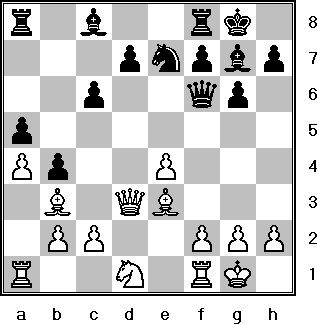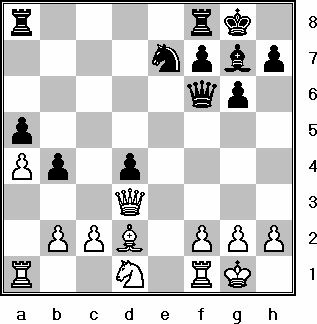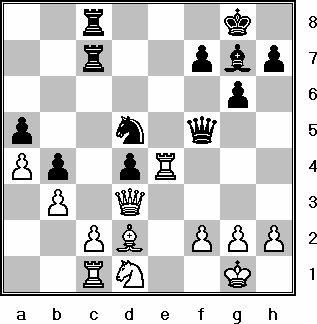|
Lesson
#12
Focus
Have you ever listened to a friend give a confusing talk? You might think
to yourself, "what is he saying? I just donít get it". Later,
perhaps another friend gives a well-presented talk with a beginning, an
appropriate story and a good conclusion. Chances are your second friend was
focused.
On the chessboard, as in life, itís good to know what youíre driving
at. When you are focused, all of your actions have a purpose. You have a clear
goal. Often itís best to focus on a weakness in your opponentís position.
Eventually, with continued focus, you can break though and achieve your goal.
Letís see how one of the greats did it in a game from 1923 between Tarrasch
and the future world champion, Alexander Alekhine (with black).
1. e4 e5 2.Nf3 Nc6 3. Bb5 g6 4. d4 Nxd4 5. Nxd4 exd4 6. Qxd4 Qf6 7. Qd3 Bg7
8. Nc3 c6 9. Bc4 Ne7 10. Be3.
Nowadays most masters would be more careful to
prevent blackís queenside pawn storm. The solution would be 10. a4 instead
of the move played. 10. Ö b5 11. Bb3 a5 12. a4 b4 13. Nd1 0-0 14. 0-0.
|

|
Black to move
|
It is fascinating to watch how Alekhine transforms the position over the next
five moves. He is focused on building a bind on the queenside. As a result,
whiteís pieces get all tied up trying to guard his weaknesses. It isnít
clear yet just where these weaknesses are. So, letís play on and find what
Alekhine wants to focus on. 14 Ö d5 15. exd5 Ba6 16. Bc4 Bxc4 17. Qxc4
You might have wondered why didnít Alekhine play these moves in a different
order? From the above diagram he could have played 14. Ö Ba6 first. This
forces 15. Bc4 Bxc4 16. Qxc4. Then he could play 16. Ö d5 with a more direct
threat. Well, the answer is that white doesnít have to take the d-pawn. He
could play 17. Qc5 blocking the queenside. Notice that the white e-pawn is
poison for if 17. Ö dxe4 then 18. Bg5 snags the knight.
It is not enough to know the right moves. You need to play them in the right
order as well.
The game continued with 17. Ö cxd5
18 Qd3 d4 19. Bd2
|

|
Black to move
|
Wow. What a change between the last two diagrams! Suddenly Alekhine has a
strong center pawn while white has no center pawns at all. And look at whiteís
sorry minor pieces. The knight canít move and keeps the rooks divided. The
bishop doesnít have anywhere useful to go. Lastly, the black rooks can jump
all over the c-file and make the white c-pawn feel very weak.
But, you might choose to point out, black has some problems too. His d-pawn
is isolated and isnít that a bad bishop with those queenside pawns stuck on
dark squares? This is true. But weaknesses are only important if the other
player can take advantage of them. Just consider how hard it would be for
white to get his knight to b3 and his bishop to f2. That would take seven moves
of shuffling around! I canít imagine that Alekhine would allow that.
Itís a joy to watch how Alekhine builds the pressure. He focuses on that
poor pawn with 19. Ö Rac8 20. Re1 Rc7 21. b3 Rfc8 22. Rc1 Qf5
Now Alekhine is threatening 23. Ö Rxc2! So
white must defend by playing the unnatural looking 23. Re4. And
after 23. Ö Nd5 all of Alekhineís pieces are marvelously placed.
|

|
Black to move
|
Itís hard to find anything useful for white to do. Probably he should just
wait with a move like 24. h3. But passive play is sometimes difficult to
stomach. So, white tries to active his knight with
24. Nb2
That white knight was on guard duty watching the c3 square. Now that heís
left his post his counterpart can invade with 24. Ö Nc3 25. Bxc3 Rxc3.
Notice that the rook takes back instead of a pawn. The lines must be kept open.
Once they are shut the black bishop really would become a bad bishop.
26. Qe2 Bh6 how about that for a "bad" bishop! Very soon
Alekhine will win the pawn that heís been focusing on. But first, white gets
to play a few attacking moves. 27. g4 Qf6 28. Re8+ Rxe8 29. Qxe8+ Kg7 30. Rf1
Rxc2 and black eventually won thanks to his extra pawn and active rook.
Be like a world champion, find a good goal and focus on achieving it. Get
your resources working as a team. Keep up the pressure and the prize will soon
be yours.
Home Page ∑
More Lessons
(c) 2001 Ross Stoutenborough
|